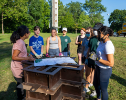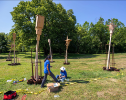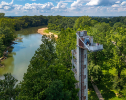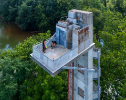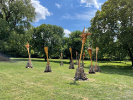UB architect unveils animal friendly installation at Exhibit Columbus
UB architecture associate professor Joyce Hwang's installation "To Middle Species, With Love" will be on display at Exhibit Columbus (Indiana) from Aug. 21-Nov. 28. Photo: Joyce Hwang
Release Date: August 19, 2021
BUFFALO, N.Y. — They’re your neighbors. They’re mostly friendly, but sometimes not, if you agitate them. They’re an integral part of what makes your community unique. And perhaps they’ve even lived there longer than you have. Yet, they’re often ignored simply because they’re not human.
“It’s probably not that often that we as humans think of animals as community members or neighbors, even though they often do live alongside us,” says Joyce Hwang, associate professor and director of graduate studies of architecture in the University at Buffalo’s School of Architecture and Planning.
“They contribute significantly to the health of our cities, yet often remain invisible in our imaginations of where we live,” adds Hwang, who hopes to bring greater visibility to the bats, birds, turtles and other reptiles and amphibians that reside in cities all across the world through a forward-thinking installation opening this weekend.
It’s called “To Middle Species, With Love,” and it is among a dozen installations being featured at Exhibit Columbus, a critically-acclaimed two-year cycle of programming that takes place in Columbus, Indiana, a city with a celebrated legacy as a laboratory for design as a civic investment. Hwang’s exhibit will be on display from Aug. 21-Nov. 28.
The annual Exhibit Columbus symposium and exhibition explores the future of cities in America’s heartland.
Hwang was one of seven University Design Research Fellow participants – scholars and design researchers from universities across the U.S. – each invited to develop an installation design that engages their respective university community. This year’s theme is New Middles: From Main Street to Megalopolis, What is the Future of the Middle City?
A team of student volunteers from the environmental club at Columbus North High School in Indiana helped UB architecture professor Joyce Hwang (far left) assemble the base structures for To Middle Species, With Love. Photo: Hadley Fruits
When humans do think of animals, it’s usually the so-called “flagship species” that first come to mind: Think the bald eagle as a symbol of the U.S., or the polar bear as representative of the urgency of climate change.
But Hwang’s new installation, similar to previous works she’s built — including Bat Tower in Griffis Sculpture Park in East Otto, New York — asks people to consider the world through the perspective of the often overlooked animals that live among us in our urban environments.
Hwang calls these the “middle species.”
Hwang recently summed up her interest in animal architecture in a Biodesigned essay, writing “What defines a post-industrial city? What does it mean to decline and decay? I am like a real estate developer looking for sites with untapped potential. But the potential I seek has to do with increasing habitat rather than increasing capital. I imagine a species-inclusive city.”
Ultrasonic detectors placed at the top of the 84-foot-tall observation tower in Mill Race Park will regularly record bat calls. The recordings will be accessible to visitors, both in-person and through online platforms. Photo: Hadley Fruits
Sited within the landscape of Columbus’ Mill Race Park, Hwang’s installation is conceived of as a series of “strata,” featuring bat and bird habitat conditions above, and environments for terrestrial and amphibious species below.
To shift human perception to sense the less visible world of urban animals, the project provides visitors ways to explore middle species sounds — particularly bat echolocation — by using ultrasonic detectors to regularly record bat calls, and make the recordings accessible to visitors, both in-person and through online platforms.
“The detectors will be triggered by bat calls, and will be recording their high frequency sound throughout the exhibition period,” Hwang notes. “As a visitor to the park, you can put on your headphones, link to a website and listen to bat calls from previous nights.”
At the higher elevations, Hwang and her team created structures that function like a typical bat house known to be used by the endangered Indiana bat. There are also a series of perches and possible nesting sites for birds using Indiana hardwoods.
At the ground level, the team used local stones to create a series of gabion-like mounds that can provide shelter for smaller terrestrial or amphibious animals. Benches and boulders invite human visitors to stop and enjoy the sights and sounds around them as their animal neighbors enjoy their new habitats.
“We’re looking to develop ways to shift human perception to sense the less visible world of urban animals and to hopefully make their presence part of the way that we experience Columbus,” Hwang says. (She describes the project in this Youtube video made for Exhibit Columbus.)
Most of the structures for middle species were created at UB using the fabrication workshop in the School of Architecture and Planning, with advisement and assistance from UB architecture alumnus Wade Georgi.
And the core installation team included UB architecture graduate students Nicole Sarmiento and Bethany Greenaway, as well as UB undergraduate Anh Shavindya Seneviratne Do. All three students have also been part of the design, research and fabrication process.
In addition, Albert Chao, an adjunct instructor in UB's Department of Architecture, and Greg Delaney, clinical assistant professor of architecture at UB, assisted Hwang in Columbus.
Media Contact Information
David J. Hill
Director of Media Relations
Public Health, Architecture, Urban and Regional Planning, Sustainability
Tel: 716-645-4651
davidhil@buffalo.edu




